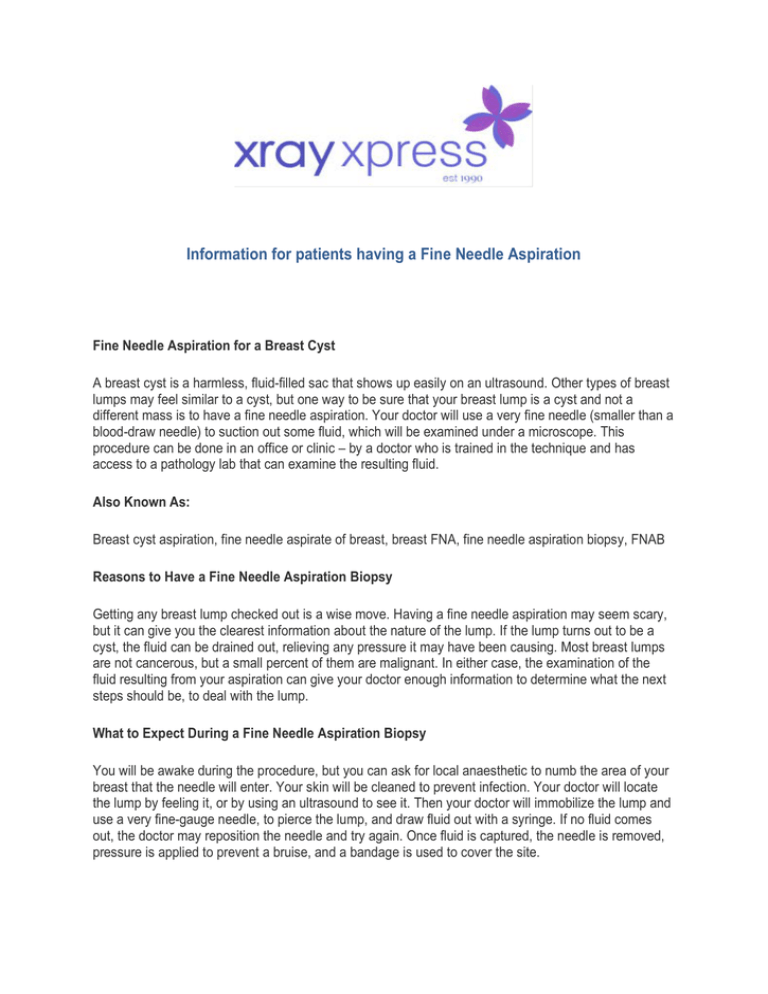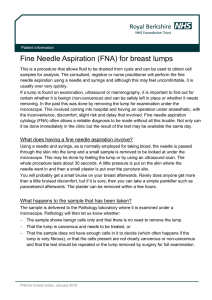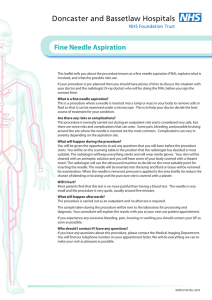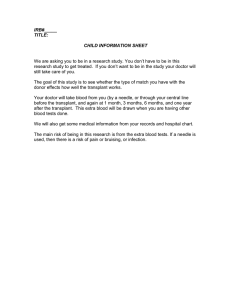Fine Needle Aspiration (FNA)
advertisement

Information for patients having a Fine Needle Aspiration Fine Needle Aspiration for a Breast Cyst A breast cyst is a harmless, fluid-filled sac that shows up easily on an ultrasound. Other types of breast lumps may feel similar to a cyst, but one way to be sure that your breast lump is a cyst and not a different mass is to have a fine needle aspiration. Your doctor will use a very fine needle (smaller than a blood-draw needle) to suction out some fluid, which will be examined under a microscope. This procedure can be done in an office or clinic – by a doctor who is trained in the technique and has access to a pathology lab that can examine the resulting fluid. Also Known As: Breast cyst aspiration, fine needle aspirate of breast, breast FNA, fine needle aspiration biopsy, FNAB Reasons to Have a Fine Needle Aspiration Biopsy Getting any breast lump checked out is a wise move. Having a fine needle aspiration may seem scary, but it can give you the clearest information about the nature of the lump. If the lump turns out to be a cyst, the fluid can be drained out, relieving any pressure it may have been causing. Most breast lumps are not cancerous, but a small percent of them are malignant. In either case, the examination of the fluid resulting from your aspiration can give your doctor enough information to determine what the next steps should be, to deal with the lump. What to Expect During a Fine Needle Aspiration Biopsy You will be awake during the procedure, but you can ask for local anaesthetic to numb the area of your breast that the needle will enter. Your skin will be cleaned to prevent infection. Your doctor will locate the lump by feeling it, or by using an ultrasound to see it. Then your doctor will immobilize the lump and use a very fine-gauge needle, to pierce the lump, and draw fluid out with a syringe. If no fluid comes out, the doctor may reposition the needle and try again. Once fluid is captured, the needle is removed, pressure is applied to prevent a bruise, and a bandage is used to cover the site. Getting Results From an Aspiration: The colour of the fluid drawn out of the lump will give some clues about its nature. If the fluid is clear or watery and not bloody, and the lump shrinks as a result of the aspiration, it is most likely a cyst. Sometimes the fluid will be white, yellow-green, brown, or bloody – only in rare cases will this mean that the lump is cancerous. If the needle draws out small bits of tissue and very little fluid, that indicates a solid mass. Those tissue samples are examined by a pathologist, to determine their nature. Results will be sent to your referring consultant. Accuracy of this Procedure A needle aspiration is 80 to 85% accurate in giving a clear indication as to whether a breast lump is a cyst or a solid breast mass. But since some possibility of error exists, it is important to go for your follow-up visits. A cyst can refill, and need more aspiration, or if a lump grows or the needle biopsy site becomes bruised, infected, or tender, your doctor should examine it again. Benefits and Risks A fine needle aspiration may result in draining a cyst, and the lump will go away. This is a good indication that the lump was not cancerous. However, some cysts do refill, and if they become bothersome, can be surgically removed. If the needle biopsy misses a cancerous lump, or if the fluid or tissue sample does not give a clear diagnosis, then your doctor may recommend doing another FNA biopsy, or a core needle, stereotactic, or open surgical biopsy. When you arrive Please report to the reception desk in the X-ray Xpress, after which you will be shown where to wait until collected by a member of staff. The procedure for your examination will be explained to you and the consultant will obtain a verbal consent. You will need to undress for the procedure and will be asked to change into a gown which will be provided. Who will you see? You will be seen by a trained consultant. Personal belongings Please keep all your valuable with you. Xray Xpress will not be responsible for any lost personal items. Special language needs If you are unable to speak English we advise that you bring someone to translate on the day of your appointment. However, they may not be allowed into the examination room with you. Disability There are very limited disabled parking spaces near the clinic. We do have a small lift in the building for access to Xray Xpress How to find us Nearest tube: Regents Park. Approximately 5 minutes walk to the clinic Bus routes: 18, 27, 30, 205 and 453 stopping at Marylebone Road Further queries Please do not hesitate to contact us if you have any queries. We are open 9.00am – 5.00pm, Mondays – Fridays with exception of bank Holidays You can call us on: 020 7224 6493 Alternatively you can e-mail us on: xrayxpress.co.uk




